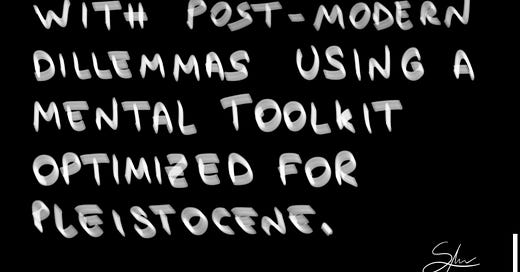Atomic Knowledge #2: Ancestral Brain Biases
We are often left grappling with post-modern dilemmas using a mental toolkit optimized for the Pleistocene.
Ancestral Brain Biases are cognitive distortions deeply rooted in human evolution, reflecting adaptations to a primitive environment that often prove inadequate in the modern world. The human brain evolved to maximize survival in contexts of immediate threats, scarce resources, and tribal social interactions, leading to responses that are frequently automatic and irrational. Examples include: 1) Confirmation bias – a tendency to seek and interpret information that confirms pre-existing beliefs. 2) Availability heuristic – judging the likelihood of events based on how easily they come to mind, rather than objective data. 3) Risk aversion and Negativity bias – a natural aversion to unfamiliar situations, originally an adaptive mechanism to avoid lethal risks.
These biases shape daily decisions, financial behaviors, political judgments, and interpersonal relationships, often resulting in distorted perceptions and inefficacy in navigating today’s technologically advanced and complex landscape. The psychological mechanisms that should manage an ever-increasing number of internal and external stimuli remain underdeveloped, untrained, and frequently neglected. As a result, we are often left grappling with post-modern dilemmas using a mental toolkit optimized for the Pleistocene.
The Ratio: whenever I encounter an interesting concept—whether it’s a theory, speculative idea, formula, or law—I strive to deeply understand it and see how it connects within my knowledge network. Once I’ve grasped its essence, I distill it into a concise, no-frills note: simple, atomic, and memorable. To keep things sharp and focused, I stick to a “lazy” limit of 1,000 characters, give or take. These atomic notes, often described as mental models, have revolutionized how I understand and link ideas, fostering a more organic and interconnected expertise. Believing in the power of sharing, I’ve decided to make them public. Think of these notes as tools: mental models to keep in your back pocket for quick use or prompts to deepen your understanding when inspiration strikes. Subscribe if you’re curious—you won’t want to miss them.




